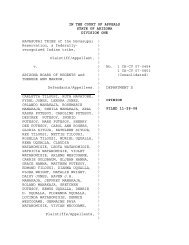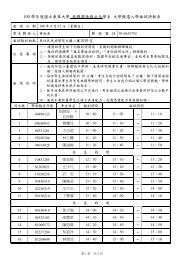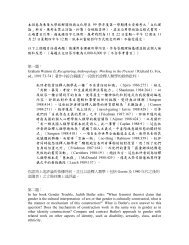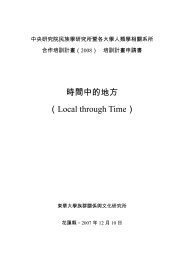Arising Light: Dr B. R. Ambedkar and the Birth of a New Era in India ...
Arising Light: Dr B. R. Ambedkar and the Birth of a New Era in India ...
Arising Light: Dr B. R. Ambedkar and the Birth of a New Era in India ...
You also want an ePaper? Increase the reach of your titles
YUMPU automatically turns print PDFs into web optimized ePapers that Google loves.
Project Beg<strong>in</strong>n<strong>in</strong>gs<br />
There is noth<strong>in</strong>g fixed, noth<strong>in</strong>g eternal …<br />
everyth<strong>in</strong>g is chang<strong>in</strong>g,<br />
change is <strong>the</strong> law <strong>of</strong> life for <strong>in</strong>dividuals<br />
as well as for society.<br />
-- <strong>Dr</strong> B. R. <strong>Ambedkar</strong><br />
My key <strong>in</strong>formant is Eleanor Zelliot (Ph.D. on life <strong>of</strong> <strong>Dr</strong> <strong>Ambedkar</strong>, 1969 U. Penn.)<br />
<strong>in</strong>terview<strong>in</strong>g her at her home <strong>in</strong> Northfield, M<strong>in</strong>nesota. I traveled to MHOW, <strong>Dr</strong><br />
<strong>Ambedkar</strong>’s birthplace, collect<strong>in</strong>g books, writ<strong>in</strong>gs, <strong>in</strong>terviews, <strong>and</strong> digital record<strong>in</strong>g <strong>of</strong><br />
historic photographs. In Nagpur, October 2005, I attended <strong>the</strong> workshop Transcend<strong>in</strong>g<br />
Barriers: <strong>Dr</strong>. <strong>Ambedkar</strong> <strong>and</strong> <strong>the</strong> Buddhist World <strong>and</strong> correspond<strong>in</strong>g International<br />
Network <strong>of</strong> Engaged Buddhists (INEB) Conference: Buddhism <strong>and</strong> Social Equality. Then<br />
to Engl<strong>and</strong> where I filmed <strong>in</strong>terviews with Sangharakshita who personally knew <strong>Dr</strong><br />
<strong>Ambedkar</strong> at his residence Madhyamaloka, Moseley, Birm<strong>in</strong>gham. In October 2006 my<br />
research was presented as a film <strong>in</strong> Nagpur to commemorate <strong>the</strong> fiftieth anniversary <strong>of</strong> <strong>Dr</strong><br />
<strong>Ambedkar</strong> embrac<strong>in</strong>g Buddhism <strong>and</strong> untimely death <strong>in</strong> 1956. The study has grown to<br />
<strong>in</strong>clude Dalit communities <strong>in</strong> <strong>the</strong> United States <strong>and</strong> Canada where especially local Punjabi<br />
followers <strong>of</strong> Guru Ravidass have become <strong>in</strong>volved <strong>of</strong>fer<strong>in</strong>g research materials. This is a<br />
story different from o<strong>the</strong>r attempts <strong>in</strong> follow<strong>in</strong>g <strong>the</strong> personal life <strong>and</strong> social movement <strong>of</strong><br />
<strong>Dr</strong> <strong>Ambedkar</strong>.<br />
It’s a project that seeks an <strong>in</strong>timate tell<strong>in</strong>g <strong>of</strong> a story based on his letters, place<br />
locations, <strong>and</strong> events <strong>in</strong> a life process that led to <strong>the</strong> mak<strong>in</strong>g <strong>of</strong> a great civil rights leader.<br />
The essence <strong>of</strong> <strong>the</strong> project is to trace Dalit agendas from <strong>the</strong> life <strong>of</strong> <strong>Dr</strong> <strong>Ambedkar</strong> to<br />
assess social, political, <strong>and</strong> economic strategies, current <strong>and</strong> <strong>in</strong> <strong>the</strong> past, that have sought<br />
to improve <strong>the</strong> lives <strong>of</strong> Dalits. It br<strong>in</strong>gs toge<strong>the</strong>r <strong>the</strong> thoughts <strong>and</strong> actions <strong>of</strong> people who<br />
cont<strong>in</strong>ue <strong>the</strong>ir peaceful mobilization by <strong>the</strong> slogan <strong>of</strong> <strong>Dr</strong> <strong>Ambedkar</strong> “educate, organize,<br />
<strong>and</strong> agitate.” As an anthropologist I am exam<strong>in</strong><strong>in</strong>g <strong>the</strong> <strong>in</strong>dividual <strong>and</strong> community<br />
dilemmas <strong>of</strong> social mobility <strong>of</strong> <strong>the</strong> Dalit. This is a story different from o<strong>the</strong>r attempts <strong>in</strong><br />
depict<strong>in</strong>g <strong>the</strong> personal life <strong>and</strong> social movement <strong>of</strong> <strong>Dr</strong> <strong>Ambedkar</strong>. It’s a project that seeks<br />
an <strong>in</strong>timate tell<strong>in</strong>g <strong>of</strong> a story based on his letters, place locations, <strong>and</strong> events <strong>in</strong> a life<br />
process that led to <strong>the</strong> mak<strong>in</strong>g <strong>of</strong> a great civil rights leader <strong>in</strong> <strong>India</strong>’s struggle for equality<br />
<strong>and</strong> justice. After <strong>in</strong>dependence <strong>in</strong> 1947, <strong>Dr</strong>. <strong>Ambedkar</strong> became <strong>India</strong>’s first M<strong>in</strong>ister <strong>of</strong><br />
Law. On 14th October 1956, at Nagpur, with a multitude jo<strong>in</strong><strong>in</strong>g him, <strong>Dr</strong> <strong>Ambedkar</strong><br />
embraced Buddhism.<br />
Introduction<br />
<strong>Dr</strong> Bhimrao Ramji <strong>Ambedkar</strong> (1891-1956) rose from <strong>the</strong> dalit 2 “undercaste” community<br />
(untouchables) <strong>in</strong> <strong>India</strong>. He educated himself <strong>in</strong> <strong>India</strong> <strong>and</strong> <strong>the</strong> West <strong>and</strong> became a national<br />
leader <strong>in</strong> <strong>India</strong>’s struggle for equality <strong>and</strong> justice. <strong>Ambedkar</strong> framed <strong>the</strong> <strong>India</strong>n<br />
constitution mak<strong>in</strong>g it a secular state <strong>and</strong> provided <strong>the</strong> national emblems <strong>of</strong> state, <strong>in</strong><br />
2 Known as “untouchable” or <strong>the</strong> community below <strong>the</strong> lowest caste <strong>in</strong> <strong>India</strong>. G<strong>and</strong>hi called <strong>the</strong>m “harijan”<br />
or children <strong>of</strong> god.<br />
2
particular <strong>the</strong> Asoka lions <strong>and</strong> <strong>the</strong> dharma wheel on <strong>the</strong> national flag. <strong>Dr</strong> <strong>Ambedkar</strong> was<br />
<strong>India</strong>’s first M<strong>in</strong>ister <strong>of</strong> Law. On October 14th, 1956, <strong>Dr</strong> <strong>Ambedkar</strong> embraced Buddhism<br />
with 500,000 o<strong>the</strong>rs. Today <strong>the</strong>re are 20 to 30 million Buddhists <strong>in</strong> <strong>India</strong>.<br />
Orig<strong>in</strong>ally <strong>the</strong> project was about <strong>the</strong> social work <strong>of</strong> <strong>the</strong> Buddhist movement <strong>in</strong><br />
<strong>India</strong> stemm<strong>in</strong>g from <strong>the</strong> work <strong>of</strong> <strong>Dr</strong> <strong>Ambedkar</strong>. It was a visual documentary depict<strong>in</strong>g<br />
20th recent humanitarian self-help education, health care, <strong>and</strong> spiritual development.<br />
Dhammachari Lokamitra 3 came up with <strong>the</strong> idea, <strong>in</strong>vit<strong>in</strong>g me to film <strong>the</strong> work <strong>of</strong> social<br />
welfare through dharma practice. In 2002 I traveled to <strong>India</strong> to document <strong>the</strong> daycare<br />
centers, hostels, cl<strong>in</strong>ics, retreat centers, <strong>and</strong> <strong>in</strong>stitutes <strong>of</strong> dalit social service. I<br />
photographed <strong>in</strong> <strong>the</strong> communities across Maharashtrai—<strong>in</strong> Mumbai, Pune, <strong>and</strong> to <strong>the</strong><br />
geographic center <strong>of</strong> <strong>India</strong>: Nagpur. At <strong>the</strong> town <strong>of</strong> Nagpur, an ancient crossroads <strong>of</strong> <strong>the</strong><br />
Deccan Plateau, it was <strong>the</strong> place where <strong>Dr</strong> <strong>Ambedkar</strong> held a ceremony to embrace<br />
Buddhism <strong>in</strong> 1956. To this day it’s pivotal for Buddhist activities <strong>in</strong> <strong>India</strong>. I filmed <strong>the</strong><br />
diksa bhumi, or grounds, <strong>and</strong> <strong>the</strong> stupa commemorat<strong>in</strong>g <strong>the</strong> event where a half million<br />
people followed <strong>Dr</strong> <strong>Ambedkar</strong> becom<strong>in</strong>g Buddhist.<br />
When Lokamitra first came to Nagpur it was on <strong>the</strong> occasion <strong>of</strong> <strong>the</strong> 21st<br />
anniversary <strong>of</strong> this event that started with <strong>Dr</strong> <strong>Ambedkar</strong> <strong>and</strong> his dalit community seek<strong>in</strong>g<br />
economic <strong>and</strong> social liberation. Lokamitra was impressed by <strong>the</strong> devotion <strong>of</strong> <strong>the</strong> people to<br />
carry <strong>the</strong> movement forward <strong>and</strong> by <strong>Dr</strong> <strong>Ambedkar</strong> himself. I was also com<strong>in</strong>g around to<br />
th<strong>in</strong>k more about <strong>the</strong> <strong>Dr</strong> <strong>Ambedkar</strong> story.<br />
My story was to show <strong>the</strong> Buddhist civilization <strong>in</strong> <strong>India</strong> from <strong>the</strong> 2nd to <strong>the</strong> 9th<br />
centuries as a dreamy montage <strong>of</strong> cliffs, rock cut shr<strong>in</strong>es, fragments <strong>of</strong> murals, <strong>and</strong> stone<br />
steps lead<strong>in</strong>g up to a film-cut <strong>in</strong>to <strong>the</strong> 20th century Mahavihara shr<strong>in</strong>e <strong>in</strong> Pune. The next<br />
scenes were a health cl<strong>in</strong>ic, daycare center, meditation retreat center, boys hostel, <strong>and</strong> <strong>the</strong><br />
diksa bhumi <strong>in</strong> Nagpur. At <strong>the</strong> Nagarjuna Institute <strong>in</strong> Nagpur, my <strong>in</strong>terview <strong>of</strong> Lokamitra<br />
came next. He told <strong>of</strong> his first visit to Nagpur on that 21st anniversary commemorat<strong>in</strong>g<br />
<strong>the</strong> rek<strong>in</strong>dl<strong>in</strong>g <strong>of</strong> a social Buddhist movement <strong>in</strong> <strong>India</strong>. 4 Lokamitra said that it was<br />
important to attend <strong>the</strong> International Network <strong>of</strong> Engaged Buddhists (INEB) <strong>in</strong> Nagpur <strong>in</strong><br />
mid-October 2005. The <strong>the</strong>me would be Transcend<strong>in</strong>g Barriers: <strong>Dr</strong> <strong>Ambedkar</strong> <strong>and</strong> <strong>the</strong><br />
Buddhist World held from 9th-16th October 2005 at Nagaloka Campus, Nagpur,<br />
Maharashtra, <strong>India</strong>. This conference encouraged an underst<strong>and</strong><strong>in</strong>g <strong>and</strong> communication<br />
between <strong>the</strong> Buddhist followers <strong>of</strong> <strong>Dr</strong> <strong>Ambedkar</strong> <strong>and</strong> <strong>the</strong> <strong>in</strong>ternational community.<br />
<strong>Dr</strong> <strong>Ambedkar</strong> viewed Buddhism as a means <strong>of</strong> br<strong>in</strong>g<strong>in</strong>g about social change based<br />
on <strong>in</strong>dividual practice <strong>and</strong> service to society. The world community has much to ga<strong>in</strong><br />
from underst<strong>and</strong><strong>in</strong>g <strong>the</strong> life <strong>and</strong> approach <strong>of</strong> <strong>Dr</strong> <strong>Ambedkar</strong>, <strong>in</strong> his conviction that<br />
Buddhism could br<strong>in</strong>g about social revolution.<br />
I participated <strong>in</strong> <strong>the</strong> 2005 International Network <strong>of</strong> Engaged Buddhists (INEB)<br />
Conference <strong>and</strong> workshops on Transcend<strong>in</strong>g Barriers: <strong>Dr</strong> <strong>Ambedkar</strong> <strong>and</strong> <strong>the</strong> Buddhist<br />
World 9th-16th October at <strong>the</strong> Nagarjuna Institute at Nagaloka, Nagpur, Maharashtra,<br />
<strong>India</strong>. At <strong>the</strong> conference I met with a community <strong>in</strong>terested <strong>in</strong> <strong>the</strong> <strong>Ambedkar</strong> movement<br />
<strong>in</strong>clud<strong>in</strong>g <strong>the</strong> Dalai Lama. I could see that <strong>the</strong> <strong>Dr</strong> <strong>Ambedkar</strong> story was needed, not only <strong>in</strong><br />
3 Founder <strong>and</strong> Director <strong>of</strong> <strong>the</strong> Jambudvipa Trust <strong>and</strong> President <strong>of</strong> <strong>the</strong> Nagarjuna Institute.<br />
4 The short film was put toge<strong>the</strong>r with a team <strong>in</strong> Taipei, Taiwan, led by Dean Karalekas <strong>and</strong> T. C. L<strong>in</strong> with<br />
visual selections by Steven Mart<strong>in</strong>, <strong>and</strong> edit<strong>in</strong>g by David Blundell, Anika Tokarchuk (June 2005), with<br />
previous edit<strong>in</strong>g by Christian Anderson.<br />
3
<strong>India</strong>, to be brought to <strong>the</strong> attention <strong>of</strong> <strong>the</strong> world. When leav<strong>in</strong>g <strong>India</strong>, Lokamitra said that<br />
I should return to film <strong>the</strong> events commemorat<strong>in</strong>g <strong>the</strong> death anniversary <strong>of</strong> <strong>Dr</strong> <strong>Ambedkar</strong><br />
on December 6th 2005. And before that time, while <strong>in</strong> <strong>the</strong> United States, to <strong>in</strong>terview<br />
Pr<strong>of</strong> Eleanor Zelliot at Northfield, M<strong>in</strong>nesota. I discovered that Eleanor Zelliot was an<br />
acqua<strong>in</strong>tance <strong>of</strong> my “god fa<strong>the</strong>r” Gordon Lewis <strong>in</strong> <strong>the</strong> 1940s as <strong>the</strong>y shared a Quaker<br />
youth education <strong>in</strong> Pennsylvania. I shared a few w<strong>in</strong>try days view<strong>in</strong>g films related to <strong>Dr</strong><br />
<strong>Ambedkar</strong> <strong>and</strong> <strong>in</strong>terview<strong>in</strong>g Pr<strong>of</strong> Zelliot at her home on a riverbank near Carleton<br />
College. From M<strong>in</strong>nesota I returned to <strong>India</strong> dedicated for <strong>the</strong> film<strong>in</strong>g about <strong>the</strong> life <strong>of</strong> <strong>Dr</strong><br />
<strong>Ambedkar</strong>.<br />
Once <strong>in</strong> <strong>India</strong> from early December I filmed <strong>in</strong> Mumbai <strong>the</strong> places <strong>in</strong> <strong>the</strong> daily life<br />
<strong>of</strong> <strong>Dr</strong> <strong>Ambedkar</strong>, from <strong>the</strong> tenement build<strong>in</strong>g where he lived most <strong>of</strong> his years <strong>in</strong> <strong>the</strong> city,<br />
<strong>the</strong> colleges he established or taught <strong>in</strong>, <strong>and</strong> <strong>the</strong> cremation site. The cremation was set on<br />
a bay shore <strong>of</strong> <strong>the</strong> Arabian Sea opposite <strong>the</strong> play<strong>in</strong>g grounds <strong>of</strong> Shivaji Park. Multitudes<br />
<strong>of</strong> pilgrims crowd to <strong>the</strong> site annually on December 6th. My film<strong>in</strong>g cont<strong>in</strong>ued at <strong>the</strong><br />
birthplace <strong>of</strong> <strong>Dr</strong> <strong>Ambedkar</strong>. It’s known as Mhow, a military base (a place where I first<br />
visited <strong>in</strong> 1976), Follow<strong>in</strong>g that visit to Pune, <strong>and</strong> aga<strong>in</strong> Mumbai.<br />
The film production is a celebration <strong>of</strong> <strong>the</strong> 50th anniversary <strong>of</strong> <strong>Dr</strong> <strong>Ambedkar</strong><br />
embrac<strong>in</strong>g Buddhism. It’s a 60-m<strong>in</strong>ute film look<strong>in</strong>g <strong>in</strong> depth at <strong>the</strong> historical <strong>and</strong><br />
sociological implications <strong>of</strong> <strong>Ambedkar</strong>'s peaceful revolution. The story <strong>of</strong> <strong>Dr</strong> <strong>Ambedkar</strong><br />
unfolds from a narrative about his leadership <strong>and</strong> a social humanitarian movement with<br />
reflections on <strong>the</strong> roots <strong>of</strong> Buddhism <strong>and</strong> ancient sources <strong>and</strong> <strong>in</strong>spirations from <strong>India</strong>.<br />
The goal <strong>of</strong> <strong>the</strong> project is to reach an <strong>in</strong>ternational audience worldwide for tell<strong>in</strong>g<br />
<strong>the</strong> story <strong>of</strong> <strong>Dr</strong> B. R. <strong>Ambedkar</strong>. The result<strong>in</strong>g knowledge could <strong>the</strong>n possibly assist<br />
people <strong>of</strong> <strong>the</strong> underclass dalit community.<br />
Children’s day-care centre, Mumbai, 2002, film clip, David Blundell.<br />
Synopsis <strong>of</strong> <strong>the</strong> Film Treatment<br />
In <strong>the</strong> late 19th century <strong>the</strong> story comes to <strong>the</strong> birth <strong>of</strong> Bhimrao Ramji <strong>Ambedkar</strong> (1891)<br />
unfold<strong>in</strong>g <strong>the</strong> current situation <strong>in</strong> <strong>India</strong> <strong>and</strong> his parents’ situation: untouchable, yet<br />
work<strong>in</strong>g with <strong>the</strong> British at a military camp, <strong>and</strong> fa<strong>the</strong>r <strong>in</strong>fluenced by Kabir who was a<br />
15th century poet critic.<br />
Bhimrao lived a sheltered life as his fa<strong>the</strong>r’s military base, not really comprehend<strong>in</strong>g<br />
be<strong>in</strong>g untouchable: <strong>the</strong> menial under-caste <strong>of</strong> <strong>India</strong>. For <strong>the</strong> first time when visit<strong>in</strong>g his<br />
fa<strong>the</strong>r stationed at ano<strong>the</strong>r place, <strong>the</strong> journey opened his eyes to his community status <strong>in</strong><br />
<strong>India</strong> s<strong>in</strong>ce most cart drivers refused untouchable people <strong>in</strong> <strong>the</strong>ir cart.<br />
4
S<strong>in</strong>ce untouchable children were forbidden education, it was one high caste teacher who<br />
noticed Bhimrao’s <strong>in</strong>telligence, helped to guide him, <strong>and</strong> eventually gave him <strong>the</strong> name<br />
<strong>Ambedkar</strong>, his own name. Bhimrao suffered <strong>in</strong>sult <strong>and</strong> humiliation from o<strong>the</strong>r students,<br />
yet overcame that to become <strong>the</strong> first graduate <strong>of</strong> his community.<br />
The Maharaja <strong>of</strong> Baroda noticed his brilliance <strong>and</strong> gave him a scholarship to Columbia<br />
University where he encountered <strong>the</strong> Afro-American community <strong>in</strong> Harlem. The 14th<br />
Amendment to <strong>the</strong> United States Constitution <strong>and</strong> <strong>the</strong> views <strong>of</strong> his pr<strong>of</strong>essors, such as<br />
John Dewey who an American philosopher <strong>and</strong> education reformer, propelled him to<br />
campaign for human rights.<br />
From his doctoral studies <strong>in</strong> economics at Columbia, Bhimrao ventured to London to<br />
achieve similar success <strong>in</strong> law. Upon his return to <strong>India</strong> <strong>in</strong> 1917, his patron <strong>the</strong> Maharaja<br />
<strong>of</strong> Baroda awarded <strong>Dr</strong> <strong>Ambedkar</strong> with a high position <strong>in</strong> government. <strong>Dr</strong> <strong>Ambedkar</strong> felt<br />
obligated at first, yet because no o<strong>the</strong>r staff <strong>in</strong> <strong>the</strong> government <strong>of</strong>fice would deal with an<br />
untouchable <strong>and</strong> <strong>the</strong>re was no lodg<strong>in</strong>g available for an untouchable, he resigned.<br />
In Mumbai, <strong>Ambedkar</strong> found government low-cost hous<strong>in</strong>g where he could reside <strong>in</strong> a<br />
10x10 foot room. He tried a law practice, yet his attention quickly turned to <strong>the</strong> suffer<strong>in</strong>g<br />
<strong>of</strong> <strong>the</strong> millions <strong>in</strong> <strong>the</strong> untouchable community. G<strong>and</strong>hi called <strong>the</strong>m Harijan, children <strong>of</strong><br />
god. Later known a Dalit, deprived people.<br />
<strong>Dr</strong> <strong>Ambedkar</strong> worked for <strong>in</strong>justice wherever it existed. To satisfy his determ<strong>in</strong>ation he<br />
proclaimed <strong>the</strong> slogan: educate, organize, agitate.<br />
To educate he taught <strong>in</strong> colleges, <strong>and</strong> later built <strong>in</strong>stitutions <strong>of</strong> high learn<strong>in</strong>g <strong>in</strong> Mumbai<br />
<strong>and</strong> across Maharashtra (central <strong>India</strong>). To organize he became a writer, publisher, social<br />
<strong>and</strong> labor leader, <strong>and</strong> established political parties. To agitate he sparred with o<strong>the</strong>r leaders<br />
<strong>of</strong> his time, such as G<strong>and</strong>hi.<br />
The <strong>Ambedkar</strong>–G<strong>and</strong>hi “Pune Pact” story is a centerpiece <strong>in</strong> <strong>the</strong> <strong>in</strong>dependence movement<br />
<strong>in</strong> <strong>India</strong>. Millions <strong>of</strong> untouchables were fight<strong>in</strong>g for <strong>the</strong>ir social rights aga<strong>in</strong>st <strong>the</strong> caste<br />
H<strong>in</strong>du society. They belonged to <strong>the</strong> same religion, yet untouchables were treated as<br />
polluted people. Caste H<strong>in</strong>du people by centuries <strong>of</strong> tradition considered <strong>the</strong>mselves pure,<br />
<strong>and</strong> could be polluted if touched by an untouchable. Though untouchables honored <strong>the</strong><br />
same deities <strong>the</strong>y could not enter <strong>the</strong> H<strong>in</strong>du shr<strong>in</strong>e. They were bound to hereditary<br />
occupations <strong>of</strong> menial labor considered unclean.<br />
G<strong>and</strong>hi appealed to <strong>the</strong> good heart <strong>of</strong> H<strong>in</strong>du people. <strong>Dr</strong> <strong>Ambedkar</strong> wanted social reform<br />
<strong>and</strong> political rights. G<strong>and</strong>hi granted untouchables <strong>the</strong>ir <strong>in</strong>divisible rights as part <strong>of</strong> H<strong>in</strong>du<br />
society. <strong>Dr</strong> <strong>Ambedkar</strong>’s slogan to educate, organize, <strong>and</strong> agitate was designed to uplift<br />
deprived people to equal status under <strong>the</strong> law. The untouchable population should <strong>the</strong>n<br />
have own political voice. G<strong>and</strong>hi wanted <strong>in</strong>dependence from <strong>the</strong> British first.<br />
5
The years from 1932 to 1947 were turbulent for <strong>the</strong> <strong>in</strong>dependence leadership <strong>in</strong> <strong>India</strong>.<br />
J<strong>in</strong>nah, leader <strong>of</strong> <strong>the</strong> Muslim League, wanted <strong>the</strong> formation <strong>of</strong> Pakistan, <strong>Dr</strong> <strong>Ambedkar</strong><br />
dem<strong>and</strong>ed separate representation for <strong>the</strong> untouchable community.<br />
Once <strong>India</strong> became <strong>in</strong>dependent from <strong>the</strong> British, G<strong>and</strong>hi <strong>in</strong>sisted that <strong>Dr</strong> <strong>Ambedkar</strong> to be<br />
<strong>the</strong> first M<strong>in</strong>ister <strong>of</strong> Law under Prime M<strong>in</strong>ister Nehru <strong>and</strong> to draft <strong>the</strong> constitution.<br />
Bhimrao <strong>Ambedkar</strong>’s life was dedicated to reform <strong>in</strong> society. He championed a moral<br />
social order that would not sanctify <strong>the</strong> exploitation <strong>of</strong> people. This egalitarian quest led<br />
him to Marxism <strong>and</strong> Buddhism. As <strong>the</strong> Buddha’s teach<strong>in</strong>g were born <strong>in</strong> <strong>India</strong>, <strong>and</strong> <strong>the</strong><br />
non-violent <strong>and</strong> rational approach impressed him, <strong>Dr</strong> <strong>Ambedkar</strong> showed <strong>the</strong> way to his<br />
community <strong>in</strong> <strong>the</strong>ir struggle for equality.<br />
Girls perform<strong>in</strong>g naga dance at <strong>the</strong> Women’s Development<br />
Centre, Nagpur, 2002, film clip, David Blundell.<br />
<strong>Dr</strong> <strong>Ambedkar</strong> is emerg<strong>in</strong>g as <strong>the</strong> au<strong>the</strong>ntic <strong>India</strong>n icon <strong>of</strong> our time.<br />
This project is to help deprived people <strong>in</strong> <strong>India</strong>.<br />
Bibliography<br />
<strong>Ambedkar</strong>, B. R.<br />
1997 The Buddha <strong>and</strong> His Dhamma. Nagpur: Buddha Bhoomi Publication.<br />
Blundell, David<br />
2006 “<strong>Aris<strong>in</strong>g</strong> <strong>Light</strong>: Mak<strong>in</strong>g a Documentary Life History Motion Picture on <strong>Dr</strong><br />
<strong>Ambedkar</strong> <strong>in</strong> <strong>India</strong>,” Hsi Lai Journal on Humanistic Buddhism, 7:463-471.<br />
Naik, C. D.<br />
2003 Thoughts <strong>and</strong> Philosophy <strong>of</strong> <strong>Dr</strong>. B. R. <strong>Ambedkar</strong>. <strong>New</strong> Delhi: Sarup & Sons.<br />
Omvedt, Gail<br />
2004 <strong>Ambedkar</strong>: Towards an Enlightened <strong>India</strong>. <strong>New</strong> Delhi: Pengu<strong>in</strong> Books <strong>India</strong>.<br />
6
Moon, Vasant (compiled by)<br />
1987 <strong>Dr</strong>. Babasaheb <strong>Ambedkar</strong> Writ<strong>in</strong>gs <strong>and</strong> Speeches Vol. 4 Unpublished writ<strong>in</strong>gs:<br />
Riddles <strong>in</strong> H<strong>in</strong>duism Education Department, Government <strong>of</strong> Maharashtra.<br />
Prasad, Ch<strong>and</strong>ra Bhan<br />
2004 Dalit Diary: 1999-2003, Reflections on Apar<strong>the</strong>id <strong>in</strong> <strong>India</strong>. Pondicherry:<br />
Navayana Publish<strong>in</strong>g.<br />
Rashtrapal, Praveen S. 2003 The Betrayal: An Inside Story. Mumbai: Samrudh Bharat<br />
Publication.<br />
Zelliot, Eleanor<br />
1996 From Untouchable to Dalit: Essays on <strong>the</strong> <strong>Ambedkar</strong> Movement. <strong>New</strong> Delhi:<br />
Manohar Publishers <strong>and</strong> Distributors.<br />
_______. 2004 <strong>Dr</strong>. Babasaheb <strong>Ambedkar</strong> <strong>and</strong> The Untouchable Movement. <strong>New</strong> Delhi:<br />
Blumoon Books.<br />
Zelliot, Eleanor, <strong>and</strong> Roh<strong>in</strong>i Mokashi-Punekar eds.<br />
2005 Untouchable Sa<strong>in</strong>ts: An <strong>India</strong>n Phenomenon. <strong>New</strong> Delhi: Manohar Publishers <strong>and</strong><br />
Distributors.<br />
7
















